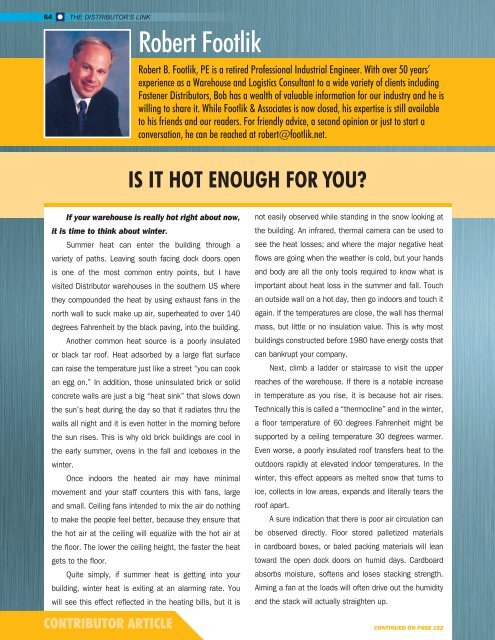FALL 2023
Distributor's Link Magazine Fall 2023 / Vol 46 No 4
Distributor's Link Magazine Fall 2023 / Vol 46 No 4
Create successful ePaper yourself
Turn your PDF publications into a flip-book with our unique Google optimized e-Paper software.
64<br />
THE DISTRIBUTOR’S LINK<br />
Robert Footlik<br />
Robert B. Footlik, PE is a retired Professional Industrial Engineer. With over 50 years’<br />
experience as a Warehouse and Logistics Consultant to a wide variety of clients including<br />
Fastener Distributors, Bob has a wealth of valuable information for our industry and he is<br />
willing to share it. While Footlik & Associates is now closed, his expertise is still available<br />
to his friends and our readers. For friendly advice, a second opinion or just to start a<br />
conversation, he can be reached at robert@footlik.net.<br />
IS IT HOT ENOUGH FOR YOU?<br />
If your warehouse is really hot right about now,<br />
it is time to think about winter.<br />
Summer heat can enter the building through a<br />
variety of paths. Leaving south facing dock doors open<br />
is one of the most common entry points, but I have<br />
visited Distributor warehouses in the southern US where<br />
they compounded the heat by using exhaust fans in the<br />
north wall to suck make up air, superheated to over 140<br />
degrees Fahrenheit by the black paving, into the building.<br />
Another common heat source is a poorly insulated<br />
or black tar roof. Heat adsorbed by a large flat surface<br />
can raise the temperature just like a street “you can cook<br />
an egg on.” In addition, those uninsulated brick or solid<br />
concrete walls are just a big “heat sink” that slows down<br />
the sun’s heat during the day so that it radiates thru the<br />
walls all night and it is even hotter in the morning before<br />
the sun rises. This is why old brick buildings are cool in<br />
the early summer, ovens in the fall and iceboxes in the<br />
winter.<br />
Once indoors the heated air may have minimal<br />
movement and your staff counters this with fans, large<br />
and small. Ceiling fans intended to mix the air do nothing<br />
to make the people feel better, because they ensure that<br />
the hot air at the ceiling will equalize with the hot air at<br />
the floor. The lower the ceiling height, the faster the heat<br />
gets to the floor.<br />
Quite simply, if summer heat is getting into your<br />
building, winter heat is exiting at an alarming rate. You<br />
will see this effect reflected in the heating bills, but it is<br />
CONTRIBUTOR ARTICLE<br />
not easily observed while standing in the snow looking at<br />
the building. An infrared, thermal camera can be used to<br />
see the heat losses; and where the major negative heat<br />
flows are going when the weather is cold, but your hands<br />
and body are all the only tools required to know what is<br />
important about heat loss in the summer and fall. Touch<br />
an outside wall on a hot day, then go indoors and touch it<br />
again. If the temperatures are close, the wall has thermal<br />
mass, but little or no insulation value. This is why most<br />
buildings constructed before 1980 have energy costs that<br />
can bankrupt your company.<br />
Next, climb a ladder or staircase to visit the upper<br />
reaches of the warehouse. If there is a notable increase<br />
in temperature as you rise, it is because hot air rises.<br />
Technically this is called a “thermocline” and in the winter,<br />
a floor temperature of 60 degrees Fahrenheit might be<br />
supported by a ceiling temperature 30 degrees warmer.<br />
Even worse, a poorly insulated roof transfers heat to the<br />
outdoors rapidly at elevated indoor temperatures. In the<br />
winter, this effect appears as melted snow that turns to<br />
ice, collects in low areas, expands and literally tears the<br />
roof apart.<br />
A sure indication that there is poor air circulation can<br />
be observed directly. Floor stored palletized materials<br />
in cardboard boxes, or baled packing materials will lean<br />
toward the open dock doors on humid days. Cardboard<br />
absorbs moisture, softens and loses stacking strength.<br />
Aiming a fan at the loads will often drive out the humidity<br />
and the stack will actually straighten up.<br />
CONTINUED ON PAGE 152
















